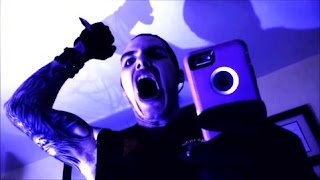Text © Richard Gary / Indie Horror Films, 2019
Images from the Internet
The Dark Days of Demetrius
Directed by Dakota Ray
R.A. Productions
60 minutes, 2019
Despite the title
sounding like a 1960s Sword and Sorcery genre release from Italy (you know,
like Demetrius and the Gladiators or something like that), rather this
is the sixth film by Dakota Ray. His specialty is life at the lowest strata of
crime in the street. And rather than being Italiano, he focuses in on
his fictional city of Sunnydale, which is actually a stand-in for his home turf
of Denver.
 |
| Dakota Ray |
This Demetrius (Dakota
Ray) is also known as the Live Stream Killer (aka LSK), as we learn from the
narration in the first 10 seconds of the film past the prologue and credits. He
kills random people and live streams it to millions of his fans who revel in
the death and destruction in his wake.
Anyone who is familiar
with Ray’s work knows it is immediately identifiable as his, as Ray has his own
style of filmmaking, which is unique, something you don’t often see these days.
While he manages to keep his “auteur” title, this film is actually way
different (and similar) as his others.
First of all, his
editing is tighter, and more importantly, his storytelling has grown. In
previous releases, most of which have been reviewed on this blog, it usually
involves a number of short stories all woven together into a tapestry of human
horror, involving murder, drugs and Satan. Here, Ray takes a single story that
runs throughout its length, though it is still broken up into chapters.
 |
| Fred Epstein |
His iconic look of
using colored filters remains, but mostly he uses a dark blue one here (and
occasionally red), almost giving the film an India Ink manga feel, full of
close-ups mixed into the action, and a voice-over to let you know what
Demetrius is thinking. You rarely hear him speak, but you hear his thoughts in
Ray’s unique, deep rumble of a voice.
Some odd things remain
the same, such as occasionally focusing on bugs and roadkill, and Ray’s
tendency to wear shorts. There is also a lot of traveling shots in a car through
the city, especially underpasses and bridges, and the characters we meet tend
to be creepy at best, and scary human monsters at their nastiest. Ray bring out
the worst traits of people, and that’s kind of what makes his stories so
interesting.
Demetrius, like many serial
killers, is a self-professed sado-masochistic narcissist. He revels in the
power of self, through the killings and his website, often looking at his own
reflection through a mirror or his cell phone camera lens. These kinds of
murderers are “hungry” for attention, and Demetrius is no different, as his
crimes become more violent, and his need for notice grows. He starts to contact
the victim’s families to taunt them, and even gets the press involved.
 |
| Lilith Frost |
Here’s where the story
twists into a Man Bites Dog (1992) situation in the “Media Manipulation:
The Devil’s Work” chapter that occurs when a news reporter, Clive (Fred
Epstein) becomes involved and begins to lose what’s left of his objectivity
(not that there really is such a thing as everything is subjective). Clive’s
background (again heard more through narration than vocalization) is a sharp
commentary on today’s news, rightly stating that people are more interested in
sensationalism than professional newscasting, and Clive is not beyond trying to
save what’s left of his reputation by leading with blood and guts. This
used to be called yellow journalism, but now it’s just common news commentary. But
Clive’s a bit of a nutcase narcissist himself, and is actually closer aligned
to Demetrius’s mindset.
The two other characters
are yet another serial killer that gets involved with Clive and his website,
Baphomet (S. Donatello, aka Sebastian Oake, who is also a producer of the
film), who wears a goat-head mask, and Bunny (Lilith Frost), a victim of
Demetrius. Frost gives a very brave performance as not only is she nude, she is
bound spread-eagled with everything open and exposed.
 |
| S. Donatello |
As one dips into the reality of situations, there are a couple of questionable actions such as
someone peeing on a body. No one would do this, because it would easily give
the police a DNA sample. In theory it makes a point of motivation of a
character, but the detective story watcher/reader in me saw this as a red flag;
on a distraction scale of one to ten in the story though, it’s probably a three.
There are some funny
moments here, and I’m not sure if they are intentional or not, such as Clive
writing about the intersection of “6th and Vagina,” which amuses me for two reasons:
the first is obvious, and the second is that it doesn’t say what 6th (Avenue?
Street? Way? Boulevard?).
A couple of more things
is that the SFX are practical (as opposed to digital) and pretty good, and most
of the music is by death metal band Emperor ov Larvae [sic].
You just know there is
a comeuppance coming for some characters, but which ones is not assured until the
end, which is a strong point for the film.
Breaking down the plot
from three intertwining stories into a single one benefits Ray’s release, and
lets the focus on the four main characters interact in a way that is more
narrative, yet retains the free-flowing form that one associates with a Ray
release. This is definitely among my faves of his films to date.

No comments:
Post a Comment